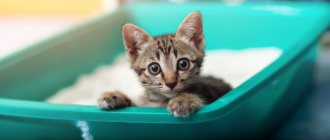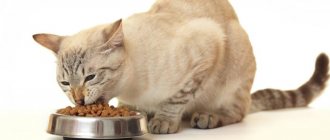Frequent urination in cats is called pollakiuria in veterinary medicine and can occur for a variety of reasons. This is a rather unpleasant condition, in which the main thing is to contact a veterinarian at the first sign in order to treat your pet as effectively as possible. Positive dynamics can only be achieved with an integrated approach, but if this condition is prolonged, then in the future there may be a lack of urination, which can lead to the death of the cat. In our article we will tell you why and under what diagnoses this condition can occur in cats, and how to treat it.
Symptoms of cystitis:
- Problems with urination. Due to inflammation, the cat has a constant feeling of fullness in the bladder. She begins to often sit down on the tray (possibly in other places) and intensively lick the genitals. In this case, urine is released literally drop by drop, or even completely absent;
- Thirst;
- Painful urination. At the end of the act, the cat may even make plaintive sounds;
- Change in the color of urine, the appearance of blood or pus in it;
- The specific smell of urine is sharp ammonia or purulent;
- Depressed state, lethargy, refusal to feed, increase and then decrease in temperature, vomiting - against the background of the development of intoxication (poisoning of the body).
Reasons why pollakiuria may occur
When the owner notices that the cat goes to the toilet little by little and often, and sometimes with blood, this may be a sign of a malfunction of not only the urinary system. Also, a similar condition occurs if a cat drinks a lot while suffering from diabetes or even when the pet is stressed. The most common causes of pollakiuria:
Cystitis
One of the most common reasons why a cat rarely walks is cystitis. Animals one year and older are predisposed to it; as a rule, a small kitten does not suffer from this disease. This disease can occur in both acute and chronic forms. The most common symptom is when the cat frequently visits the litter box and urinates in small portions, possibly even with blood or pus. When visiting the toilet, the kitten meows pitifully, may go next to the litter box, walks slightly hunched over, and often licks the perineum. The most common causes of cystitis:
- Metabolic disease.
- Formation of sand and kidney stones.
- Improperly balanced nutrition for a kitten, as a rule, most often it is: low fluid intake, low-quality dry food, insufficient amount of protein.
- Infectious diseases.
Urolithiasis disease
One of the common causes of a condition where a cat urinates little by little is urolithiasis. Veterinary statistics claim that the main category of sick animals is a neutered, middle-aged cat. However, there are times when a kitten may suffer from this complex disease.
The following symptoms will help you understand that your cat has urolithiasis:
- Urine is released literally drop by drop.
- The kitten often visits the litter box, but sometimes without success.
- The cat is walking around with blood.
- Vomiting, which occurs rarely at the beginning of the disease, and then quite often.
- Temperature increase.
- The kitten becomes lethargic and apathetic.
A pet can get urolithiasis if it has suffered from infectious diseases, is obese (therefore a neutered cat is most predisposed to it), has a genetic predisposition, or drinks too much water.
There are some cat breeds that are most predisposed to this disease: Siamese, Persian, Scottish Fold.
Psychological problems
Sometimes a cat often goes to the toilet due to psychological trauma, which may be caused by stress. It is stress that leads to a decrease in immunity, and therefore the kitten begins to get sick often, which leads to an inflammatory process in the urinary system. A kitten may experience stress in the following cases:
- Changing of the living place.
- The appearance of a new litter box can have a detrimental effect on the urinary system; the kitten quickly gets used to such an intimate container that with its change it can not only categorically refuse to go to the new litter box, but also acquire unwanted diseases.
- Change of bed.
- Change of usual food.
- Change of relationship with the owner. If the beloved owner has lost interest in the cat or is forced to spend a lot of time at work, then she is acutely worried about this moment.
- When a new kitten appears in the house, the old cat experiences stress about this.
- A cat is a very clean animal; when it has a regularly dirty litter box, it is very difficult for it to use, which can lead to problems with urination.
When a cat is stressed, he urinates frequently, and he urinates in small portions, sometimes even with blood. The pet also exhibits an aggressive state and anxiety. Frequent urination due to a stressful situation can lead to blockage of the urinary tract.
Diabetes
A kitten suffering from diabetes may urinate frequently because it drinks a lot, but in this case there is no urination of blood. Your pet's extreme thirst occurs either due to the heat or due to diabetes. If it’s hot, then there’s nothing to worry about, but when the temperature is normal, and the cat is constantly thirsty, then this may be a signal that it needs to be checked for diabetes. Very often, neutered cats suffer from it, as they sometimes become obese, which can lead to hormonal imbalance.
Urinary incontinence
Sometimes it may seem that the cat is often running to the toilet, but in fact it is urinary incontinence. Due to spinal injuries, age-related changes in the bladder, and stress, frequent urges to urinate occur, urine leaks, and pressure on the bladder increases. Most often, old and sterilized animals suffer from this disease.
Leaving marks
Another factor in portioned urination is territory marking. This may be the behavior of the animal. Sometimes even a kitten can mark territory. In this way he satisfies his feelings for the owner, this is especially true when the owner brings another pet.
Causes of cystitis
- Hypothermia of the animal, for example, the cat staying in a draft for a long time, under an open window, on a cold floor or windowsill
- Inflammatory processes in organs close to the bladder
- Complication of other diseases of the genitourinary system: pyelonephritis (inflammatory kidney disease of predominantly bacterial nature), urolithiasis or damage to the urinary organs by parasites
- Mechanical damage to the urethra
- Poor circulation due to injury
- Improper feeding of a cat - unbalanced natural diet, dry food with low water consumption or overeating, leading to obesity and an increase in the concentration of salts in the urine. As a result, the kidneys cannot cope with the filtration and elimination of toxins, swelling of the urethra occurs and the outflow of urine is impaired - a sediment of salts and mucus is formed, the urethra is blocked, urolithiasis develops, and cystitis becomes chronic.
- Low activity of the pet, physical inactivity, which slows down the metabolism.
- Parasites (helminths (worms), fleas, ticks, lice eaters) that contribute to mechanical damage to the external genitalia. Since the anus is located next to the urethra, when the cat licks itself, the infection spreads to the bladder. In addition, parasites secrete toxins that disrupt metabolism and cause secondary cystitis.
- Bacterial and viral infections (including those acquired through mother's milk or introduced during mating). Cystitis can be caused by diseases of viral etiology, which can be prevented with annual vaccination - calicivirus, rhinotracheitis and chlamydia. Each of them is chronic and has a carrier form. This form without clinical signs is one of the causes of cystitis. Treatment of cystitis in this case does not give results: as soon as it stops, cystitis returns.
- A state of anxiety or stress in a cat.
- Idiopathic cystitis (IC) - cystitis with no apparent cause - a situation where clinical signs (frequent, painful urination, blood in the urine, etc.), confirmed by tests, are present without identifying any clear reasons for the development of the disease (bacterial infection, urolithiasis, etc.). IC is more often observed in overweight cats that do not leave the house.
Features of cystitis
Both male and female cats are susceptible to cystitis. But clinical manifestations in cats are much more common. This is due to anatomical features. In cats, the urethra is straight, short and wide, so salt crystals are excreted almost unhindered in the urine. In cats, the urethra is longer, has bends and narrowings, so mucus and salt plugs often appear in it, completely blocking the flow of urine (obstruction).
Neutered cats, whose genitourinary system functions differently than normal cats, are more prone to cystitis. In addition, stagnation of blood in the genitals leads to swelling, and this leads to spasms and urinary retention, stagnation in the bladder, salt loss, urolithiasis and chronic cystitis.
Sometimes, with cystitis, pets avoid using their litter box because they associate it with pain when urinating. And in some cases, the fear of the toilet remains even after complete recovery. Thus, cystitis can cause behavioral changes.
Normal behavior
The frequency and volume of urine a cat produces depends on its age and diet. For example, kittens up to 3 months old walk once a day. As the diet expands and grows, the frequency of urination increases to 3-5 times a day. If a cat eats dry food, then it needs additional water intake, which causes frequent urges to urinate. This also applies to active animals - with high physical activity, the frequency of urination becomes more frequent as water consumption increases.
Why is cystitis dangerous?
thickening of the walls of the bladder with chronic cystitis.
Cystitis can be acute or chronic . Without measures, acute cystitis becomes chronic, which is difficult to treat. Chronic cystitis is more common in older animals, and its main symptom is the presence of blood in the bladder. With chronic cystitis, changes occur in the walls of the bladder, hypertrophy of the muscle layer develops, that is, the bladder does not empty completely. As a result, an infection accumulates, which manifests itself as another attack of cystitis.
In advanced cases, cystitis is complicated by the development of purulent processes. Inflammation from the bladder rises to the kidneys, causing their disease (pyelitis), provokes the formation of salt stones, and the development of paresis or paralysis of the bladder. In severe cases, the inflammatory process spreads into the abdominal cavity, causing peritonitis.
With obstruction (blockage) of the urethra, internal pressure in the bladder, ureter and renal pelvis increases, this leads to kidney blockage - a complete cessation of urine output. The animal's condition quickly deteriorates due to the development of intoxication (lethargy, apathy, vomiting and a specific smell of exhaled air). Part of the function of the kidneys in removing toxic products can be taken over by the skin, lungs, and digestive organs - in this way the body tries to reduce the concentration of toxins and save life. Without emergency veterinary care, urethral obstruction in cats can be fatal within 24-48 hours.
Diagnosis of cystitis
When the first signs of the disease appear, you should contact a veterinary clinic. To confirm the diagnosis you will need:
- urine test result. Depending on the severity of the inflammatory process, protein, mucus, leukocytes, red blood cells, epithelium, pus, blood, and salt crystals may be present in the urine. The laboratory must also conduct a bacteriological study (bacterial culture) to isolate pathogenic microflora (cocci, streptococci, Escherichia coli, Pseudomonas aeruginosa, etc.) and determine the reaction to sensitivity to antibiotics
- cystoscopy - examination of the bladder using a special device
- ultrasonography
- clinical and biochemical blood tests, which may indicate kidney problems and other abnormalities
- Possible smear test for genital tract infections
Treatment of cystitis
When the first signs of cystitis appear, you should provide the animal with peace and warmth; you can warm the stomach with a heating pad. It is necessary (!) to remove food from the cat, which will help stop the increase in urine concentration and reduce the load on the kidneys to eliminate metabolic products. It is also important to increase the amount you drink, as the liquid “flushes” the bladder. For cystitis, diuretics are also very useful - decoctions of lingonberry leaves, half-palm, etc. (only if there is no blockage of the urinary canal!)
Treatment is prescribed by a veterinarian depending on the complexity of the disease. For acute bacterial cystitis, long-term antibiotics are prescribed. In severe cases, it is possible to wash the bladder with a solution of potassium permanganate, furatsilin, etc. Usually, for cystitis, diuretics, homeopathy (Kantaren), Cat Erwin, vitamins and immunocorrectors are prescribed. If urination is painful, painkillers may be prescribed, and if infectious complications occur, sulfa drugs used to treat urinary tract infections.
If cystitis in a cat is a consequence of another disease of the genitourinary system, then this disease should be treated first.
In any case, you should not self-medicate cystitis; this can harm the animal.
After treatment, a repeat urine test is necessary to ensure there is no infection.
Diagnosis and treatment
Treatment for frequent urination in cats begins with identifying the cause of the behavior. If it was caused by diseases of the internal organs, then only a specialist doctor - a veterinarian - can help. Otherwise, time may be lost and the pet will die.
The standard set of procedures for diagnosing the causes of frequent urination is to:
- general urine and blood analysis;
- Ultrasound of the genitourinary system;
- determination of blood glucose levels;
- presence of acetone.
A physical examination and medical history is important. The owner needs to remember everything that happened to his pet.
Based on the data obtained, the doctor will determine the cause of frequent urination in the cat and prescribe treatment.











